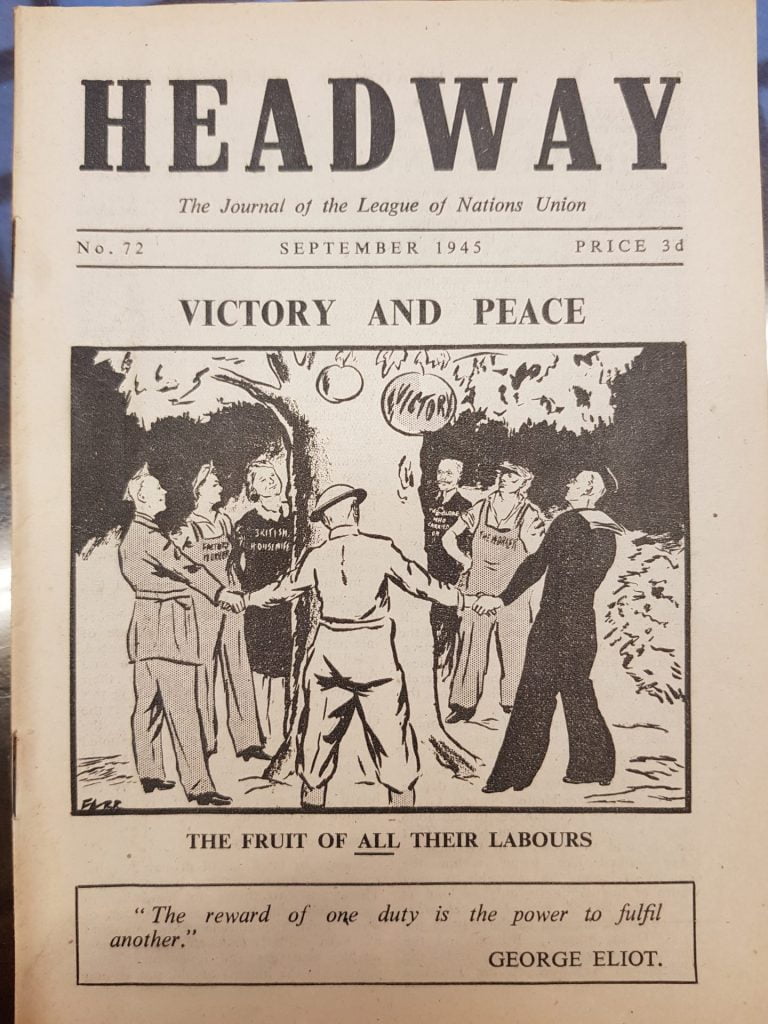The United Nations Association (Wales)
Prior to World War 2, Wales had one of the world’s most active peace movements in the form of the Welsh League of Nations Union (WLNU). However, six years of the world’s deadliest conflict had take its toll, and when hostilities ceased – on 8th May 1945, VE Day for Britain (‘Victory in Europe’) ; and 2nd September 1945 for America, VJ Day (Victory over Japan’) – peace movement in Wales and the world over found themselves reforming practically from scratch – and in a very different world.
The interwar WLNU morphed into 2 new organisations, UNA Wales (the United Nations Association) and CEWC (the Council for Education in World Citizenship), from 1945 onwards.

- Starting from May 16 1942, the WLNU’s Education Advisory Committee drafted a new constitution for a Welsh Association for Education in World Citizenship, which was agreed on July 11 1945, and formally established from Summer 1946.
- Jan 1944 WLNU Executive met in Shrewsbury to agree proposals for post-war operations. Newly appointed General Secretary William Arnold had travelled Wales canvassing WLNU members’ views on future work, producing a ‘Transition Report & Recommendations’ for the Council – categorising local branches into 4 levels for future activity (49 x category ‘A’ active groups; 150 x ‘B’ branches for revival; 100 x ‘C’ campaigns-only contacts, and remainder ‘D’ defunct branches.
- July 24 1945 – WLNU Executive endorsed the Dumbarton Oaks proposals and UN Charter, and resolved to transition into UNA Wales, aligned with UNA UK.
- Oct 27 1945 – Last AGM of WLNU and Inaugural / transitional meeting of UNA – and the first held at Temple of Peace – endorsed a new constitution, process for local WLNU branches to ‘transfer’ into UNA Wales, and for other associations to affiliate.
- 1 Feb 1946 – First Executive meeting of newly formed UNA Wales met in Shrewsbury, producing shortly after the first postwar WLNU / UNA Wales Annual Report for 1943-46.
- August 1946 – World Federation of United Nations Associations launched in Luxembourg, organised by a secretariat seconded from the Temple of Peace staff, and adopting a constitution and preamble drafted by Wales – the ‘Charter of Luxembourg’.
- 30-31 May 1947 – First Annual Meeting of the UNA Wales National Council and member branches was held in Wrexham’s Guildhall, where the change of name was ‘formally’ approved (although by then ‘UNA Wales’ had been in operational use for 3 years).
- Over 26-27 June 1948, the 3rd AGM for UNA UK was hosted at Wales’ Temple of Peace, welcoming delegates from the UK and Commonwealth.
UNA Wales had a far harder task as a campaigning body than the interwar WLNU. Britain remained in Austerity, and had been practically bunkrupted by the war. Many of the ‘interwar generation’ of peace leaders had passed away (Lord Davies, Annie Hughes Griffiths, David Samways) or were in advanced years (Gwilym Davies passed away by 1954). Regular philanthropic donations from the ‘great and the good’ were no longer the mainstay of voluntary organisations finances; which meant that UNA Wales had to operate strictly within the means of its own membership income.
The Temple of Peace after the War

The Temple, opened in November 1938 just months before the outbreak of war, had been a place of pilgrimage throughout WW2. It had suffered minor bomb damage in 1942, when two incendiary bombs had pierced the roof, luckily failing to explode. Many services had been held at the Temple not only for visiting groups, but for servicemen billeted in Wales. The Temple had been overseen by a Warden, Major Edgar Jones of Barry (father of 1930s journalist Gareth Jones, who had exposed the Ukrainian Famine).
The first major post-war event in 1946 sadly was the Memorial Service for founder Lord David Davies of Llandinam, who had passed away in 1944. This was followed, more joyfully, by a ceremony marking the delayed presentation of the RIBA Gold Medal to Temple Architect Sir Percy Thomas, presented by Lord Davies’ widow Lady Henrietta Davies, who championed UNA Wales until her passing in 1948.
International Youth Service for European Reconstruction – the beginning of UNA Exchange
After WW2, Europe was in tatters, and it would take 2 decades for reconstruction to clear away the devastation of war. International youth service was developed as a means of supporting reconstruction efforts, and through the 1950s and 1960s UNA was one of the leading organisations coordinating such projects.
Human Rights in a Postcolonial Era
The horrors of WW2, the Holocaust and mistreatment of entire peoples’ had driven home the importance of human rights to everybody in the post-war era. And in the United Nations climate, Britain could neither morally or financially afford to sustain an Empire exerting colonial power over peoples of the world. The End of Empire and transition to Independence enabled many more voices at the UN to champion the rights of small nations and peoples.
Cold War and the Nuclear Threat
However, forever cast over the post-WW2 Peace was the shadow of Hiroshima and Nagasaki. That the US and Allied Powers had ended the war by deploying such as horrific device as the atomic bomb, ushered in a whole new anxiety and era for peace campaigning – and the birth of the Campaign for Nuclear Disarmament (CND)
